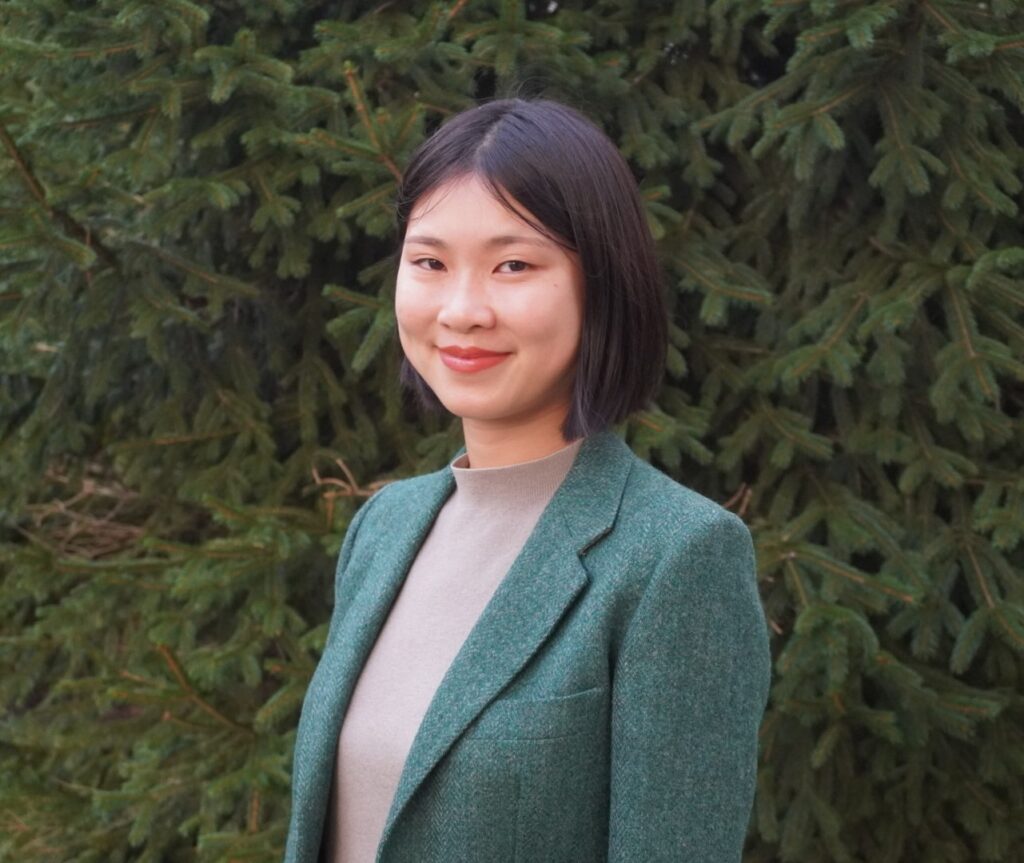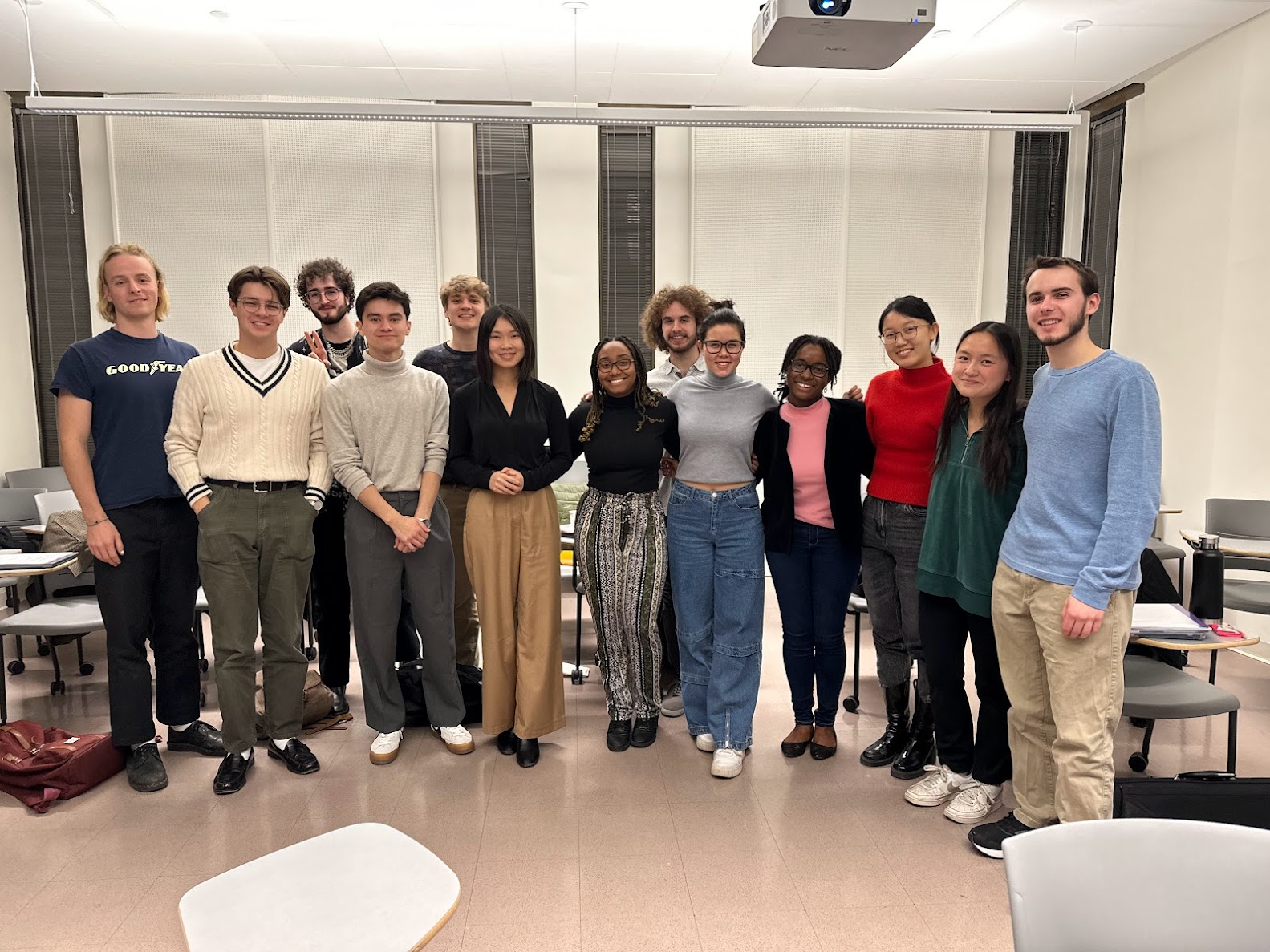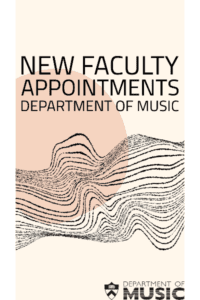When the Department of Music welcomed Assistant Professor Anna Yu Wang to campus at the beginning of the 2023-24 academic year, we noted that her arrival was “more sforzando than crescendo.” With the busy fall semester now officially in the rearview mirror, Professor Yu Wang takes a well-deserved breath and a moment to reflect. In this interview, she shares insights into her fall-semester course “Thinking Through Musical Sound” and reflects on how it broadened students’ (and her own) perspectives on music and world-making.
The below conversation has been edited for clarity and concision.
Your approach to music emphasizes cross-cultural literacy. How did “Thinking Through Musical Sound” align with this goal of culturally expansive music analysis?
In this class, we’re construing music theory as the study of how and why we listen the way we do. The thesis of my course was that listening is inextricable from world-making — how we imagine, make sense of, and make our way through the world. Students were encouraged to look at how their own habits of listening are culturally situated within larger intellectual and physical environments. For example, how might what they find to be a “good” sound reflect certain tacit ideals within and beyond the sonic sphere?
Who were the class participants?
There were a lot of computer science majors and engineering majors, a student from SPIAA, a student studying anthropology, and another studying art and archaeology. I think the draw of this course for STEM majors in particular was this idea that we can approach music as something that both transcends cultural boundaries and that remains culturally modulated, which may be of interest to students who epistemically value understanding how systems exert themselves both in locally particular and global senses. During our penultimate class, for example, we had a fruitful debate on whether academics should invest considerable time and resources into studying musical universals. Part of that debate was defining these “universals” — are they musical structures that occur invariably across cultures, or are they structures that can be found in most but not all musical cultures? The students all had to read literature beforehand and interweave what they read with their own opinions — some of which had changed quite drastically since the start of the semester.
Tell us more about those changes. How else were students challenged by the course content throughout the semester?
Frankly, I’ve been challenged by the course content! And I think it’s in a similar way to how the students themselves experienced the challenge of this work. Almost every week we were dealing with new musical material from a different cultural and historical context. It was work that required a special agility and an openness to re-situating ourselves constantly. We might define a term one week in one context only to have its meaning change the following week because it’s been placed in a new context.
In another sense, this class quite literally tasked students with confronting a musical challenge: for their semester projects, I asked them to identify a sonic structure that currently challenges the way that they tend to listen — a musical structure that confounds their ear — and to unpack how it conveys beauty, coherence, or meaning to its local listeners. Students wade into the weeds of their sound structures by interviewing culture bearers, reading relevant scholarly literature, and, for some, by learning that musical tradition on an instrument in one-on-one lessons. They strove to ascertain what it is that their sonic structure communicates both overtly — the emotional, gestural, physical, and narrative implications that their interlocutors understand when they hear the structure — and covertly — as in the ideological implications of attending to that sonic structure.
Who were those interlocutors that students engaged with?
All of the interlocutors were musical thinkers, but all working in different contexts. Some of the students reached out to scholars whose articles they read. Some reached out to teachers. Two students took lessons, one in Carnatic singing and one in Carnatic violin playing; another student took lessons on campus with Olivier Tarpaga in dundun drumming. Another student went to New York City to do interviews and ethnographic observation of a Javanese gamelan ensemble. It’s my hope that we can continue strengthening the bonds between the community and the university in this way. It would enrich everyone’s work, as the fabulous projects presented at the expo have demonstrated.
Speaking of, can you share a few highlights from your course’s culminating expo?
Because this work was so student-directed — the students managed everything from identifying the premise of their project to selecting who in the community would be good interlocutors to determining the method of study — I was eagerly anticipating this expo as the moment when I could finally see what the students had accomplished. The expo was structured as a series of lightning talks by the students.
One student researched a style of singing known as Ganga, which is based in mountainous, shepherding regions in Bosnia, Croatia, Kosovo, Serbia, Slovenia, and Montenegro. In particular, he showed how the close intervals — often corresponding in quality to major and minor seconds—characteristically performed by Ganga singers resonate with a pastoral mode of living. Based on his interviews, the student found that not only would such close intervals project further across vast landscapes, but they also imitate and aestheticize the spectral sonority of local church and sheep bells. Listening closely to Ganga, he also found interest in the subtle fluctuations in pitch often added by singers to the end of sustained tones–called “exhales”–which he learned were meant to evoke the delicate and improvised sounds of bird calls. I appreciated how this student was able to show how ideas from the world around us become embedded into the musical sounds we create in which it exists.
Another student, who was studying avaz, a metrically free vocal section in Persian classical pieces, did a virtuosic job of illustrating its formal and tonal structure through impactful visual aids. He then examined a prominent, fluttering sonic structure involving the modulating intonation of a sustained pitch–known as tahrir. He explained that tahrir literally translates to “setting at liberty,” and allows the avaz to develop freely and to sound as fresh and spontaneous as the song of a nightingale (the latter which is held as a symbol of the highest level of musical artistry). His presentation culminated in his own composition of an avaz, through which he sensitively showcased his understanding of tahrir. He even performed his composition himself on a Chinese bamboo flute, showing an impressive effort in cross-cultural listening. In light of Western colonialism, imperial expansion, and other forms of transnational exchange, the global ubiquity of Western musical instruments also make them the familiar facilitators of cross-cultural musical expression perhaps most typical to hear. This made it all the more striking to me to hear the Chinese bamboo flute take on this kind of intercultural labor.
What did some of the other students present at the expo?
One student studied a musical structure in gong kebyar–a contemporary style of Balinese gamelan music– called byar, which is an explosive timbral wash in which all the metallophones in the gamelan strike the same note with fiery intensity. The student was curious about the communicative and ideological implications of that structure, and what he found through scholarly readings and interviews is that it is related to the Balinese concept of ramé, a sort of social busyness, where there are lots of different agents creating one space together. This idea was also brought into connection with another concept, briuk sepanggul, which refers to many people playing with one mallet to create one sound. The student then connected these concepts to the Balinese cosmology of dualities — the idea that, in one pole, there also the other pole, or, in other words, within diversity there is oneness.
And the student who studied Carnatic violin presented on tala, the metric cycles that Carnatic music follows. This student is a violin player, but trained in Western art music. Through her research, she began to piece together a sort of embodied vocabulary or framework of understanding for Carnatic violin playing. First, she found that Tala metaphorizes bodily gestures and parts of the body. She reported that, etymologically, if you break “tala” down, “ta” refers to male dance while “la” refers to female dance, so tala are about dancing bodies, while the smaller components of a tala are named after human limbs In her presentation, the student also contrasted her embodied experience playing the violin in the Western art music setting with the Carnatic tradition. She explored how, in Carnatic violin playing, the instrument is played seated, leading the instrumentalist to have a more centered feeling in the body; in addition, because the violin is held downwards, the force of gravity is present in a lot of the finger work. Her demonstration of these ideas confirmed my hope that these instrument lessons (generously funded by the Music Department) would open up students’ understanding of sonic structure not only in an intellectual, but also an embodied way. It brings to life an idea developed in the work of music theorist Jonathan De Souza, who theorized that musical instruments lead us to orient our bodies in unique ways. Perhaps we could go as far as to say that they lead us to orient ourselves to the world in unique ways.
Read more from Anna Yu Wang.
In Other News

Gavin Steingo Named 2024-25 Getty Research Institute Scholar
Jun 28, 2024
The Department of Music is excited to announce that Gavin Steingo, Professor of Music and Director of Undergraduate Studies, received a prestigious year-long fellowship at the Getty Research Institute (GRI) in …

Anna Yu Wang Named 2024 Luce/ACLS Early Career Fellow in China Studies
May 24, 2024
The Music Department at Princeton is proud to announce that Anna Yu Wang has been awarded a 2024 Luce/ACLS Early Career Fellowship in China Studies.

Cultivating Aluminum Flowers: Inside Steven Mackey’s Latest Electric Guitar Concerto
May 6, 2024
Steven Mackey’s Aluminum Flowers, a concerto for solo electric guitar and orchestra, made its world premiere on March 9, 2024 at the Kimmel Center. This concert featured jaw-dropping virtuosity of polymath guitarist JIJI.



